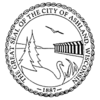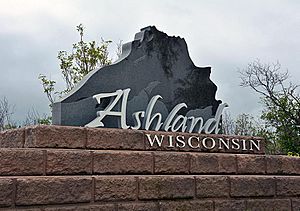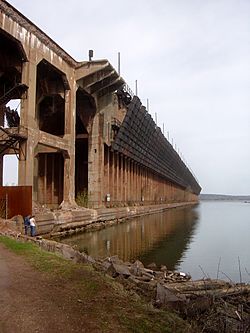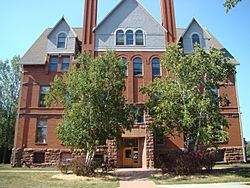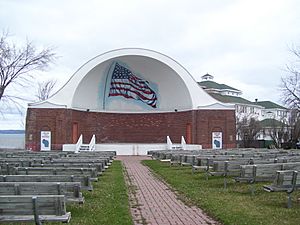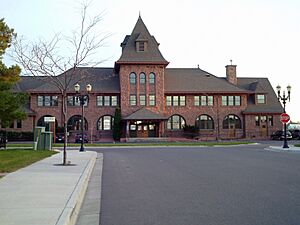Ashland, Wisconsin facts for kids
Quick facts for kids
Ashland, Wisconsin
|
||
|---|---|---|
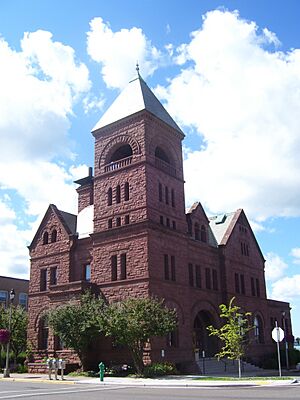
Ashland City Hall was built in 1893 from locally quarried brownstone.
|
||
|
||
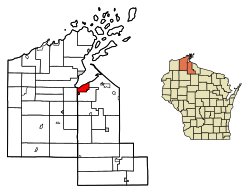
Location of Ashland in Ashland County
and Bayfield County, Wisconsin |
||
| Country | United States | |
| State | Wisconsin | |
| Counties | Ashland, Bayfield | |
| Area | ||
| • Total | 13.60 sq mi (35.22 km2) | |
| • Land | 13.35 sq mi (34.56 km2) | |
| • Water | 0.26 sq mi (0.66 km2) | |
| Elevation | 671 ft (205 m) | |
| Population
(2020)
|
||
| • Total | 7,908 | |
| • Estimate
(2021)
|
7,918 | |
| • Density | 581.47/sq mi (224.53/km2) | |
| Time zone | UTC−6 (CST) | |
| • Summer (DST) | UTC−5 (CDT) | |
| ZIP code |
54806
|
|
| Area codes | 715 & 534 | |
| FIPS code | 55-03225 | |
| GNIS feature ID | 1560982 | |
| Public Transit | Bay Area Rural Transit | |
Ashland is a city in Wisconsin, located in Ashland and Bayfield counties. It is the main city of Ashland County. The city is a port on Lake Superior, found near the start of Chequamegon Bay. In 2020, about 7,908 people lived here. Most of the city is in Ashland County.
Ashland is where US Highway 2 and WIS 13 meet. It is also home to Northland College, Northwood Technical College, and the Sigurd Olson Environmental Institute.
Contents
A Look Back: History
Early Days Before Settlement
Many Native American groups lived around Chequamegon Bay long ago. Later, European explorers, missionaries, and fur traders came. Then, people from the eastern United States arrived to build and develop the land. They were joined by railroad workers, shippers, and loggers. Four different flags have flown over the Ashland area: Spanish, French, English, and American.
This area was once part of the United States' Northwest Territory. It was managed as different territories before becoming part of Wisconsin. These included the Indiana Territory, Michigan Territory, Illinois Territory, and Wisconsin Territory.
Around the late 1400s, the Ojibwe people came to this land. They called it Sha-ga-waun-il-ong, which means things like "lowlands" or "region of shallow water." The Ojibwe lived on Chequamegon Point for almost 100 years. They then moved to Madeline Island and later to the Sault Ste. Marie area.
The first Europeans known to visit Chequamegon Bay were French fur traders Pierre d'Esprit and Medard Chouart. They arrived in 1659. They built what is thought to be the first European home in Wisconsin. A historical marker at Maslowski Beach in Ashland shows this spot.
The Ojibwe people welcomed the French traders. Five years later, Father Claude-Jean Allouez, a Jesuit missionary, arrived. He brought the first message of Christianity to Wisconsin. Father Allouez built a chapel near the traders' fort. He lived and worked at the Bay until 1669.
How Ashland Was Settled
In 1854, Asaph Whittlesey and George Kilborn from Ohio explored Chequamegon Bay. Whittlesey built a small cabin in Ashland. His wife, Lucy, and daughter, Eugenia, joined him in August. They prepared to spend the winter in their new home.
The first community dance was held at their house. The first sermon was preached there on Independence Day. This village also had the first post office and voting place. A Sunday school was held there too.
The Milwaukee, Lakeshore and Western Railroad planned the city in 1885. This happened as the railroad moved west. A local landowner, Martin Beaser, named the settlement Ashland. He named it after the home of Kentucky statesman Henry Clay. Before this, the area was called Bay City, Saint Mark, or Whittlesey.
In the 1800s, many families from Germany and northern Europe moved to the area. They were often drawn by farming or mining jobs. This is why there are many Lutheran churches in town.
Difficult Times During World War I
During the last year of World War I, from March to October 1918, some unfair attacks happened in Ashland. These attacks were against men of German background. They were thought to have supported Germany during the war.
Groups of masked men would take people from their homes at night. They would drive them to quiet places. There, the men were attacked and humiliated. A group called the Knights of Liberty said they were responsible. They wrote to a local paper saying they wanted "prompt punishment" for any "treasonable" acts.
Some of the people who were attacked included:
- Professor E. A. Schimler, who taught French at Northland College.
- Bartender Adolph Anton, who was accused of being "pro-German."
- William Landraint, a 62-year-old tax assessor. He had lost his job due to unfair treatment.
- Farmer Martin Johnson from nearby Sweden, Wisconsin.
- John Oestrycher, a farmer who was attacked for not buying Liberty Bonds.
The governor of Wisconsin, Emanuel Philipp, was very upset by these events. He ordered an investigation. However, people in the area were not helpful. No one was ever found guilty for these attacks. Two months after the war ended, the Knights of Liberty group broke up.
Important Dates in Ashland's History
- 1856 — The first map of Ashland was made.
- 1870 — The first Ashland brownstone was dug up and sent out.
- 1872 — The first sawmill was built by W.R. Sutherland.
- 1872 — The Ashland Weekly Press newspaper started. It became a daily paper in 1888.
- 1874 — The first brewery, Ashland Brewing Company, was built.
- 1877 — The Wisconsin Central Railroad connected Ashland to Chicago.
- 1887 — The state government officially made Ashland a city.
- 1889 — The Wisconsin Central Depot was built.
- 1892 — Northern Wisconsin Academy opened (now Northland College).
- 1892 — The Ashland Post Office was built.
- 1904 — Ashland High School opened.
- 1918 – During the war, several men faced unfair attacks from vigilante groups.
- 1929 — The first airport opened.
- 1940 — WATW radio started broadcasting.
- 1970 — The Apostle Islands National Lakeshore was created.
- 1972 — Memorial Medical Center opened.
- 1979 — The Union Depot was added to the National Register of Historic Places.
- 1984 — The West Second Street Historic District was added to the National Register of Historic Places.
- 1998 — The Northern Great Lakes Visitor Center was built.
- 2009 — The old ore dock was planned to be taken down.
- 2014 — The Chapple and MacArthur Avenues Residential Historic District was added to the National Register of Historic Places.
- 2016 — A new fire hall was opened.
- 2016 — From July to August, Ashland had very bad storms. Highways and areas like Saxon Harbor were badly damaged. Many basements flooded.
The Ore Dock
The harbor of Ashland used to have a very large Wisconsin Central Railway (later Soo Line) ore dock. It was built in 1916. Its job was to load iron ore from local mines onto large ships. These ships would then take the ore to places like Ashtabula, Ohio, where steel was made.
This dock was the last of many such docks. It was made of concrete and was about 80 feet high and 75 feet wide. In 1925, the dock was made even longer, to 1800 feet. It was last used to ship ore in 1965.
By 2007, the dock was in bad shape. It was named one of the "10 most endangered historic buildings in Wisconsin." This was done to try and save it. But inspections showed it was unsafe. In 2009, permission was given to take it down. Most of the dock was removed by 2013.
The concrete base of the ore dock is still there. The city took ownership of it in 2014. They are now planning how to use this historic spot for new projects.
Geography and Climate
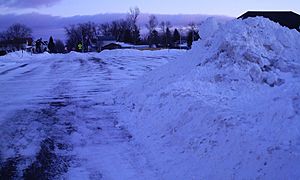
Ashland is located along the south shore of Chequamegon Bay. The city covers about 13.70 square miles. Most of this area is land, with a small part being water.
Ashland's Weather
Ashland has a humid continental climate. This means it has four clear seasons. Winters are very cold. Because the city is close to Lake Superior, it sometimes gets heavy lake effect snow storms.
| Climate data for Ashland, Wisconsin (John F. Kennedy Memorial Airport), 1991–2020 normals, extremes 1893–present | |||||||||||||
|---|---|---|---|---|---|---|---|---|---|---|---|---|---|
| Month | Jan | Feb | Mar | Apr | May | Jun | Jul | Aug | Sep | Oct | Nov | Dec | Year |
| Record high °F (°C) | 58 (14) |
62 (17) |
84 (29) |
91 (33) |
96 (36) |
99 (37) |
107 (42) |
103 (39) |
100 (38) |
94 (34) |
78 (26) |
60 (16) |
107 (42) |
| Mean maximum °F (°C) | 41.2 (5.1) |
47.0 (8.3) |
60.0 (15.6) |
75.6 (24.2) |
84.7 (29.3) |
89.4 (31.9) |
90.9 (32.7) |
89.1 (31.7) |
85.2 (29.6) |
77.5 (25.3) |
59.7 (15.4) |
45.0 (7.2) |
92.9 (33.8) |
| Mean daily maximum °F (°C) | 22.3 (−5.4) |
26.6 (−3.0) |
37.8 (3.2) |
50.6 (10.3) |
64.4 (18.0) |
73.4 (23.0) |
78.9 (26.1) |
77.1 (25.1) |
69.0 (20.6) |
55.4 (13.0) |
40.1 (4.5) |
27.6 (−2.4) |
51.9 (11.1) |
| Daily mean °F (°C) | 14.0 (−10.0) |
17.2 (−8.2) |
27.9 (−2.3) |
39.5 (4.2) |
51.5 (10.8) |
61.0 (16.1) |
66.7 (19.3) |
65.1 (18.4) |
57.4 (14.1) |
45.0 (7.2) |
32.3 (0.2) |
20.1 (−6.6) |
41.5 (5.3) |
| Mean daily minimum °F (°C) | 5.8 (−14.6) |
7.7 (−13.5) |
17.9 (−7.8) |
28.5 (−1.9) |
38.6 (3.7) |
48.5 (9.2) |
54.5 (12.5) |
53.2 (11.8) |
45.8 (7.7) |
34.7 (1.5) |
24.5 (−4.2) |
12.6 (−10.8) |
31.0 (−0.6) |
| Mean minimum °F (°C) | −17.7 (−27.6) |
−15.6 (−26.4) |
−6.9 (−21.6) |
14.1 (−9.9) |
25.8 (−3.4) |
34.3 (1.3) |
43.1 (6.2) |
40.8 (4.9) |
30.5 (−0.8) |
21.3 (−5.9) |
5.7 (−14.6) |
−10.9 (−23.8) |
−20.6 (−29.2) |
| Record low °F (°C) | −41 (−41) |
−40 (−40) |
−30 (−34) |
−5 (−21) |
16 (−9) |
23 (−5) |
32 (0) |
29 (−2) |
12 (−11) |
0 (−18) |
−16 (−27) |
−32 (−36) |
−41 (−41) |
| Average precipitation inches (mm) | 0.64 (16) |
0.70 (18) |
1.12 (28) |
2.26 (57) |
3.45 (88) |
3.92 (100) |
3.93 (100) |
3.44 (87) |
3.03 (77) |
2.83 (72) |
1.55 (39) |
0.98 (25) |
27.85 (707) |
| Average precipitation days (≥ 0.01 in) | 6.7 | 6.2 | 7.8 | 10.0 | 12.1 | 12.9 | 12.9 | 13.9 | 12.7 | 11.3 | 8.9 | 7.9 | 123.3 |
| Source: NOAA | |||||||||||||
People and Population
| Historical population | |||
|---|---|---|---|
| Census | Pop. | %± | |
| 1890 | 9,956 | — | |
| 1900 | 13,074 | 31.3% | |
| 1910 | 11,594 | −11.3% | |
| 1920 | 11,334 | −2.2% | |
| 1930 | 10,622 | −6.3% | |
| 1940 | 11,101 | 4.5% | |
| 1950 | 10,640 | −4.2% | |
| 1960 | 10,132 | −4.8% | |
| 1970 | 9,615 | −5.1% | |
| 1980 | 9,115 | −5.2% | |
| 1990 | 8,695 | −4.6% | |
| 2000 | 8,620 | −0.9% | |
| 2010 | 8,216 | −4.7% | |
| 2020 | 7,908 | −3.7% | |
| 2021 (est.) | 7,918 | −3.6% | |
| U.S. Decennial Census | |||
Population in 2020
In 2020, Ashland had 7,908 people. The city had about 591.7 people per square mile. There were 3,860 homes.
Most people (80.5%) were White. About 10.0% were Native American. Other groups included Black or African American (1.0%), Asian (0.8%), and Pacific Islander (0.1%). About 7.2% of people were from two or more races. About 2.8% of the population was Hispanic or Latino.
Population in 2010
In 2010, there were 8,216 people living in Ashland. There were 3,516 households and 1,942 families. The population density was about 612.2 people per square mile.
About 87.0% of people were White. Other groups included Native American (7.5%), African American (0.5%), and Asian (0.5%). About 4.0% were from two or more races. About 2.1% of the population was Hispanic or Latino.
About 26.6% of households had children under 18. About 37.7% were married couples. The average household had 2.17 people. The average family had 2.81 people.
The average age in the city was 38.6 years. About 21% of people were under 18. About 16.3% were 65 or older. The city was 48.2% male and 51.8% female.
Economy and Jobs
Ashland has several large companies. These include:
- Bretting Manufacturing, which makes machines for folding paper.
- Larson-Juhl, a company that makes picture frames. It is part of Berkshire Hathaway.
- H Windows, a company that makes windows.
Many small businesses also help the local economy. Tourism is very important, especially in the summer. Tourists come to enjoy activities on the Great Lakes.
Education in Ashland
Public Schools
- Lake Superior Primary/Intermediate/Charter School
- Marengo Valley Elementary School
- Ashland Middle School
- Ashland High School
Private Schools
- Ashland Seventh-day Adventist School
- Celebration Christian Academy
- Our Lady of the Lake School
- Zion Lutheran Christian School
Colleges and Universities
- Northland College
- Northwood Technical College
Media and News
News Media
- Ashland Daily Press, a local daily newspaper.
- Bottom Line News and Views
Radio Stations
- WATW 1400 AM – Conservative talk radio
- WUWS 90.9 FM – Ideas network of Wisconsin Public Radio
- K210CG FM 91.9 – Plays Contemporary Christian music, from Duluth's KDNW
- WBSZ 93.3 FM – Country music
- WWMD-LP 95.3FM – Christian talk radio (Catholic)
- WJJH 96.7 FM – Rock music
- WIMI 99.7 FM – Adult Contemporary music (from Ironwood, MI)
- W284AN 104.7 FM – News and Classical Music from Wisconsin Public Radio
- WEGZ 105.9 FM – Christian talk radio (from Washburn, WI)
- WNXR 107.3 FM – Oldies music (from Iron River, WI)
Television Stations
TV stations for Ashland come from the Duluth area:
- 3 KDLH (CBS)
- 6 KBJR (NBC)
- 8 WDSE (PBS)
- 10 WDIO (ABC)
- 21 KQDS (Fox)
Getting Around: Transportation
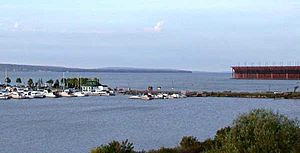
The two main highways in Ashland are US 2 and WIS 13.
Railroads
Ashland is one of the northern end points in Wisconsin for the Canadian National Railway (CN). This company owns the old Soo Line tracks. However, after floods in 2016 damaged bridges, CN stopped service to Ashland. Trains now only go as far north as Park Falls.
Ashland has not had passenger train service since 1971. But both the Union Depot and the Soo Line Depot are still standing. They are listed on the National Register of Historic Places.
Airports Near Ashland
Airports that have commercial flights near Ashland include:
- Gogebic-Iron County Airport (about 54 miles away in Ironwood, Michigan)
- Duluth International Airport (about 92 miles away in Duluth, Minnesota)
- Rhinelander-Oneida County Airport (about 119 miles away in Rhinelander, Wisconsin)
Other public airports near Ashland are:
- John F. Kennedy Memorial Airport (about 2 miles away in Ashland)
- Madeline Island Airport (about 17 miles away in La Pointe, Wisconsin)
- Cable Union Airport (about 37 miles away in Cable, Wisconsin)
- Park Falls Municipal Airport (about 58 miles away in Park Falls, Wisconsin)
Public Transportation
Local transportation is provided by Bay Area Rural Transit (BART). This non-profit system has bus stops around the community. BART also offers rides to nearby towns like Washburn and Bayfield.
Bus service between cities is provided by Indian Trails.
Northern Towns Transport is a car service. It connects Ashland and the Chequamegon Bay area to downtown Minneapolis, Minnesota and its airport. It also connects to Superior, Wisconsin / Duluth, Minnesota and Duluth International Airport.
Churches in Ashland
- Trinity Evangelical Lutheran Church of the Wisconsin Evangelical Lutheran Synod (WELS)
- Our Lady of the Lake Catholic Community
- Chequamegon Unitarian Universalist Fellowship
- Saron Lutheran Church
- Good Shepard Lutheran Church
- Zion Lutheran Church
- First English Lutheran Church
- Salem Baptist Church
- Lighthouse Baptist Church
- Church of Jesus Christ of Latter-Day Saints
- Kingdom Hall of Jehovah's Witnesses
- First Assembly of God Church
- Seventh-day Adventist Church
- United Methodist Church
- First Covenant Church
- Calvary Tabernacle United Pentecostal
- Celebration Fellowship
- United Presbyterian Congregational Church
Arts and Culture
The Chequamegon Bay Arts Council helps promote art in northern Wisconsin. It is a non-profit group.
The Ashland Chamber Music Society is a volunteer group. They arrange concerts for local musicians to play chamber music.
The Bay Area Film Society is for movie fans. They show classic films.
The Chequamegon Symphony Orchestra (CSO) performs concerts for people in northern Wisconsin.
Fun Things to Do: Recreation
You can find many natural places nearby. These include Lake Superior, the Whittlesey Creek National Wildlife Refuge, and the Chequamegon-Nicolet National Forest.
Parks in Ashland
- Bayview Park (also called Pamida Beach) has a swimming beach, bathrooms, fishing pier, picnic area, and playground. A 10-mile walking trail connects to the park. Bayview Park is the only beach in Ashland with lifeguards in the summer.
- Beaser Park
- Kreher Park (also called Sunset Park) has 33 RV campsites by Lake Superior. It has a swimming beach, playground, showers, and firewood. This park connects to the Ashland Waterfront trail.
- Maslowski Beach has a shallow, sandy swimming beach. It also has a playground, pavilion, bathrooms, and changing rooms. You can access Ashland's Lake Front Trail from here.
- Memorial Park has a band shell, often used for outdoor music.
- Menard Park
- Prentice Park is Ashland's largest park, about 100 acres. It is a natural home for migrating birds and mute swans. It has hiking trails, picnic areas, a playground, and tent camping.
Trails for Hiking and Biking
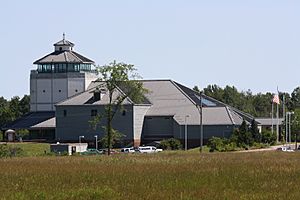
- Tri-County Corridor
- Lakefront Trail, along Lake Superior
- A walking trail goes around the whole city.
- North Country Trail
Boating
- Ashland Marina, located behind the Hotel Chequamegon.
Camping
- RV camping is available at Prentice Park and Kreher Park.
- Tent camping is available at Prentice Park.
Local Attractions
- Ashland Historical Museum
- Northern Great Lakes Visitor Center – a place with exhibits about nature and history.
- The Chequamegon Theatre Association is in the historic Rhinehart Theatre.
- Ashland Chequamegon Bay Golf Course
Events and Festivals
- Bay Days is Ashland's yearly community festival in mid-July. It has street vendors, live music, a "Strongest Man in the Bay Contest," and a Sprint Triathlon.
- The Book Across the Bay ski race happens every February. Skiers cross the frozen Chequamegon Bay from Ashland to Washburn.
- The WhistleStop Marathon and half-marathon is held every fall. It brings athletes from many areas.
- Live chamber music concerts are performed by the Ashland Chamber Music Society.
- The annual Red Clay Classics car race is held at ABC Raceway.
- The Ashland Area Farmer's Market is held weekly on Saturday mornings in the summer.
- Holiday parades include a Fourth of July parade, a Christmas parade, and a Homecoming parade.
- The Ashland County Fair is usually in September at the fairgrounds in Marengo.
- The Chequamegon Bay Bird & Nature Festival is held in May.
- The Superior Vistas Bike Tour is held in June.
- Garland City Women's Expo is held in November.
- Chick-uamegon 5k & 10k run
Famous People From Ashland
- Ove H. Berg, Wisconsin state representative
- Janet Bewley, member of the Wisconsin Legislature
- Abe L. Biglow, Wisconsin state representative
- Bob Blake, NHL player
- Bob Brevak, racing driver
- F. Taylor Brown, U.S. Navy admiral
- Ray Callahan, MLB pitcher for the Cincinnati Reds
- John C. Chapple, Wisconsin state representative and newspaper editor
- Moose Cochran, NFL player
- Norm DeBriyn, former head coach of the Arkansas Razorbacks baseball team
- Sean Duffy, U.S. congressman
- Sam Fifield, 14th lieutenant governor of Wisconsin, and noted businessman
- Moose Gardner, professional football player
- Bernard E. Gehrmann, Wisconsin state representative
- Jack Hall, labor organizer and trade unionist
- Morgan Hamm, Olympic medalist
- Paul Hamm, world champion gymnast, Olympic gold medalist
- Everis A. Hayes, U.S. representative from California
- Andrew R. Johnson, a Louisiana state senator and mayor of Homer, Louisiana. He lived in Ashland in the 1890s. In 1901, he named the village of Ashland, Louisiana, after Ashland, Wisconsin.
- John Kingston, Jr., Wisconsin state senator
- Jim Kisselburgh, football player
- Clarence A. Lamoreux, Wisconsin state senator
- Lawrence A. Lamoreux, Wisconsin state representative
- William D. Leahy, U.S. Navy Fleet Admiral, the first military officer to reach a five-star rank. He was also Chief of Naval Operations, governor of Puerto Rico, U.S. ambassador to France, and White House Chief of Staff for two presidents.
- Michael A. McAuliffe, U.S. Air Force brigadier general
- Robert Bruce McCoy, U.S. National Guard major general
- George F. Merrill, Wisconsin state senator
- Jennifer Ouellette, science writer
- Sigurd F. Olson, author
- William Plizka, member of the Wisconsin Legislature
- Joe Rogalski, MLB player
- Albert W. Sanborn, Wisconsin state senator
- Fritz Scholder, Native American artist
- John C. Sibbald, Wisconsin state representative
- John W. Slaby, Wisconsin state representative
- Dave Suminski, NFL player
- John Szarkowski, photographer
- Daniel Theno, Wisconsin state senator, Ashland mayor
- A. Pearce Tomkins, Wisconsin state senator
- Harry P. Van Guilder, Wisconsin state representative
See also
 In Spanish: Ashland (Wisconsin) para niños
In Spanish: Ashland (Wisconsin) para niños


